#4: I, Shi Zhengli, guarantee with my life that SARS2 is not related to 'my' lab
How an Asian woman's transparency became a Western man’s conspiracy
Same disclaimer from part 3: this is obviously a Wuhan lab leak hypothetical based on an accident, not an accusation. This is a series of posts not so much to discuss ‘lab’ leak but ‘what’ leaked.
This is written to answer the two most important questions:
Why did WIV publish RaTG13 on January 24, 2020, kickstarting engineering rumors by US virologists, leading to a February 1st teleconference drafting a natural origin paper, later edited, referenced, and distributed by Fauci in a major April press conference?
Why only North American (lab) animals (not Chinese bats), can become both infected and ‘efficiently’ transmit SARS2?
Shi was busy flying around
Shi Zhengli, a top Chinese virologist, left the Singapore bat conference on December 9th, 2019, and traveled back home to a relatively calm Wuhan. By December, SARS2 was quietly circulating in northern Italy, France, Norway, and America. Also, by mid-December, many US professors knew of a Wuhan outbreak. Most of us would not learn of a city named Wuhan until late January 2020.
International video link
Shi runs a coronavirus lab at the Wuhan Institute of Virology (WIV) but was there for about two of the last four months of 2019. She was busy hosting Wuhan conferences and traveling to Sweden, Africa, and Paris. She then attended an opening ceremony for a new Wuhan CDC BSL2 lab on December 12th. The brand new lab moved to the north side of the Yangtze River, within 1,000 feet of the infamous Wuhan wet market.

The Wuhan CDC opening lab ceremony may have been the second superspreader event of 2019, because Wuhan hospitals on the north side of the Yangtze River filled up with sick patients in late December. Shi then traveled to Shanghai for a December 30th conference. The exact location was never clarified, but a Shanghai meeting at the same time was sponsored by the University of North Carolina (UNC).
ECNU University in Shanghai (Linfa Wang’s alma mater) was also a NIAID subcontractor shipping samples to “US partners.” Linfa appeared on Singapore news after the Nipah conference to generate some fear and to solicit funding.
On the same day, December 30th, the Wuhan Institute of Virology (WIV) received and isolated the first Wuhan pneumonia patient samples. The SARS2 samples came from Jinyintan Wuhan Hospital, which is located on the north side of Yangtze River. Late December 2019 was at least two months after a potential October lab leak from the BSL4, located on the south side of the river.
Per the CIA, “China’s officials probably did not have foreknowledge that SARS2 existed before WIV researchers isolated it (on Dec 30th).” And there is a Chinese proverb; "the mountains are high and the emperor is far away."
International video link
Shi’s BSL2 lab vs Dani’s BSL4 lab
While in Shanghai, Shi received a call from her civilian boss, Yuan Zhiming, and her first thought was, “Could (SARS2) have come from our lab?” Shi checked her lab database on the train ride home to Wuhan. On January 2nd, she found an old lab sample relatively close to SARS2 but not exact. “That really took a load off my mind. I had not slept a wink for days.”
Shi’s BSL2-3 lab was one of a dozen labs in Wuhan, but her lab specialized in coronaviruses. Zhiming told NBC News no WIV employees or 3rd party contractors tested positive for SARS2. Zhiming was the US trained director of the WIV. He sent “high importance” emails to NIH in 2016 “asking for help” and warned of low maintenance funds in September 2019.
The brand new BSL4 lab was Zhiming’s 13-year project. Beijing provided funding since they were embarrassed after SARS1 in 2003. The French, who built the BSL4, faded from view as the WIV signed a Letter of Support in 2013 with Fauci’s NIAID, for bat sample collection and for sharing. That same year, UTMB became the training center for WIV technicians, and UNC started reverse engineering Chinese pathogens in 2015-16.
The $42M BSL4 lab was not for everyday experiments. Only a handful of the WIV’s 300 scientists had been trained to use it, including Shi, the deputy director.
Danielle ‘Dani’ Anderson was one of the few others trained to use the BSL4. She was an “unpaid visiting scientist during regular short trips” to the WIV from her Duke lab in Singapore. Visitors called the brand new BSL4 “state-of-the-art, in contrast to other, aging WIV buildings, where the scientists in the older downtown buildings wore coats indoors in winter because of scant heating.”
Shi’s research office (Xiaohongshan) and the lab is a BSL2-3 on the older downtown Wuchang campus. The BSL4 is located in Jiangxia, which is 15 miles south of downtown. “I’m sure that I did nothing wrong, so I have nothing to fear,” Shi told the NYT. Shi tried to prove her innocence by publishing the nearest bat sample the WIV lab had previously collected in 2013. It is now called RaTG13, but it was 1200 nucleotides different and decades away from evolving to SARS2.
Shi entered the international limelight on January 23, 2020, the same day Chinese authorities sealed off Wuhan to contain a new disease. In a preprint paper, her team announced that it had found a virus 96.2 percent identical to the novel coronavirus.
Just one week later, on February 2nd, Shi “guaranteed with my life that (SARS2) is not related to (my BSL2) lab.” Before 2020 “we had never been in contact with or studied this virus, nor did we know of its existence.” In 2021, when asked about the three sick WIV technicians, Shi would say there were none, but asked the NYT, “If possible, can you provide the name of the three to help us check?”
Dani, the last and only Western scientist in Wuhan, was working inside the BSL4 lab until November 29, 2019. By February 2020, Dani worked on an antibody test so “we could trace back patients who have been infected previously.” She has not spoken to the media since a grant called DARPA Defuse leaked via DRASTIC in September 2021. Her Western name was listed on the 2018 grant outlining work in Wuhan that was very similar to SARS2.
False confession?
Shi’s attempt at transparency turned her into the #1 international suspect because her lab possessed the closest (known) genetic match to SARS2. Looking back, Shi’s publication may go down as the bravest decision in this sordid tale of cowards.
“We can never prove something that doesn’t exist. All these attacks on us come from the U.S. and are unfounded. We never had this novel coronavirus in our lab, let alone handled it. Before December 30, 2019 such a virus did not exist in our lab. There could not have possibly have been a lab leak. So this kind of attack is invalid.” Shi’s remarks are quoted from an August 2020 interview.
Nearly two years later, also in September 2021, a closer match to SARS2 emerged in Laos. This bat sample was collected by the US military in 2017 and partially published by UNC in 2018. The Laos bat cave sample is 150+ miles south of the China border. The US Navy office that collected the Laos sample is next door to Linfa and Dani’s Duke lab in Singapore and the two agencies worked together.
If the WIV knew about the Laos Banal samples in January 2020, why not publish it instead of the biological headache called RaTG13?
Who is this fearless woman?
Dr Shi Zhengli was born in 1964 in a small village from Henan province. She grew up in one of the poorest areas of the poorest countries in the world. It was rural China that seeded her fascination with bats. “Bats are a symbol of blessing in traditional Chinese culture. We often see bat motifs in jewelry, ceramics, and buildings in remote villages.” Based on a recent US Government funded study, most of the Chinese peasants near these rural bat caves live on less than $1,500 USD per year.

Shi moved five hours south, during a period of mass urbanization, to the growing opportunities in Wuhan. It was the “City of a hundred lakes,” of which just 30 remain from its urban growth. Wuhan was always a large business town called the “Chicago of China'' by an American magazine in 1900, exporting tea and silk to the West. The locals call it China’s Thoroughfare since it is a centrally located transportation hub.
Shi graduated with a biology degree from the prestigious Wuhan University in 1987. This is where she met her husband, who is a professor at a local university. She received a master’s degree in virology from Wuhan Institute of Virology in 1990. She started as a WIV research assistant, studying aquatic diseases like fish and shrimp viruses.
In December 1985, James LeDuc of UTMB, visited the WIV to help work on a trial of drug efficacy for the hantavirus, a life-threatening disease transmitted by rodents. “China was emerging from the Cultural Revolution. Everyone was on bicycles,” he recalls. “I can remember giving a talk—the screen was a sheet one of us had to hold. The windows were broken out.”
In February 2020 LeDuc emailed coauthor Zhiming a list of questions that Shi partially answered in April 2020.
North American hantavirus transmits in deer mice so American scientists used them to study self-disseminating vaccines. SARS2 also transmits efficiently in deer mice.

A career change
In 2000, Shi got her PhD in virology from France and then returned home. Wuhan would grow with her from a sleepy backwater of wet markets into a modern metropolis full of 34 Walmarts, 4 GM, and 2 Honda car plants. It has doubled in size over the past 30 years to 8 million people.
Shi spent the first half of her career studying aquatic diseases in a city that floods often. Nearly half of her 125 published papers were about aquatic diseases. In fact, every published paper on her CV from 1994-2005 was about Chinese shrimps, crabs, prawns, crayfish, and diseases like white spot syndrome that affect them.
Her career changed after the 2003 SARS outbreak in Beijing. There she met a US-educated Chinese virologist named Linfa Wang, with whom she published her first bat paper in 2005. Linfa was running the “Bat pack” lab in Australia at the time and made his name connecting the local Hendra horse virus to bats. He was tasked with finding the origin of SARS in China. He hypothesized bats were the origin and said, "Shi was the only virologist who believed me and was willing to collaborate with me."

In 2003, Shi visited Linfa’s BSL4 lab in Australia. She met Dani for the first time and returned for three months in 2006 as a visiting scientist. In 2012, NIAID funded Linfa’s Australian horse vaccine (of course!) in Australia’s huge BSL4. This was the only BSL4 on the planet big enough to house horses.
NIAID would later search for a BSL4 lab ‘small enough’ to house tiny Chinese horseshoe bats. Linfa tried to keep a Chinese horseshoe bat colony alive but gave up. Shi would return to Wuhan and slowly learn how to keep these high-maintenance, insect-eating bats alive in biolab captivity.
Zhang Huajun said in 2009: "The research team captured a few bats from the wild to be used as experimental animals. They need to be fed every day.” Many people were not aware that Ms. Shi silently took on the task of raising bats.
Harvesting bats and bat samples was hard work
Shi and Linfa would search for a decade trying to link SARS to bats, but it was hard work. Most Chinese horseshoe bats roost in deep, narrow caves on steep terrain, and scientists could only collect a dozen bats per expedition. In 2004, her team collected samples from 408 bats across China.
The remote location of Chinese bats, roosting in deep caves on steep cliffs, made a contagious animal vaccine very economical. In fact, proponents funded by NIH used “cost as the primary value of self-spreading vaccines.”
Most of these expeditions over the past decade were funded by Fauci’s NIAID and USAID Predict. Both US bureaucracies used Peter Daszak’s EcoHealth, located in New York City, as an intermediary. All the Chinese bat samples would be shipped to US biolabs “for further characterization.”

For years, the raison d’etre for EcoHealth’s research in China and elsewhere has been “bio-surveillance.”
The aim, Daszak said, is “to find out which of the viruses in the wild even possibly could infect people so we know where they are and we can stop them from emerging.”
“It’s a little bit like if you listen to phone calls from Afghanistan. To find the terrorists, you have to listen to all the phone calls,” Daszak said. “Only when you’ve heard the phone call do you then go in and find out who these people are and disrupt those networks.”
The nonprofit organization partnered for years with a USAID program called Predict (and the Pentagon). Launched in 2009, the program took tens of thousands of wildlife samples and identified hundreds of new viruses that could pose a threat to humans in order to create an “early-warning system” for the next pandemic.
After seven years of searching, Shi and Linfa published what they were looking for, a coronavirus strain that came from Chinese horseshoe bats. It was 97% identical to SARS1 found in the 2003 wet markets. This discovery put Shi on the Western virologist radar, for better or worse, becoming known as the “Bat Woman.”
The WIV1 sample was ~25% different from SARS2 and the only sample Shi was able to clone (genetically modify) in her lab. The same WIV1 bat sample was later used in North Carolina for in vitro tests in human airway cells. A WIV1 bat sample was also used in Montana for an in vivo test on live Egyptian fruit bats.
SARS2 transmits in Egyptian fruit bats and infects human airway cells. Both are exclusive to Western labs and are further discussed below.
The WIV1 and SHC014 bat samples were sent to US labs, but there was no direct record of Shi sending the 2013 RaTG13 sample to US labs. There was indirect evidence in 2018 that Shi did send RaTG13 to her US lab collaborator at UNC and RML.
The now famous Bat Woman travels the world
Shi and Linfa presented at a 2017 Washington, D.C. conference when Fauci was a keynote speaker. Shi and Dani visited Colorado State University (CSU) in 2017 for a bat conference. This bat meeting included Fauci’s aerosol specialist and bat vaccine immunologist, Vincent Munster, from Rocky Mountain Lab (RML) in Montana. Munster visited the WIV in 2015.
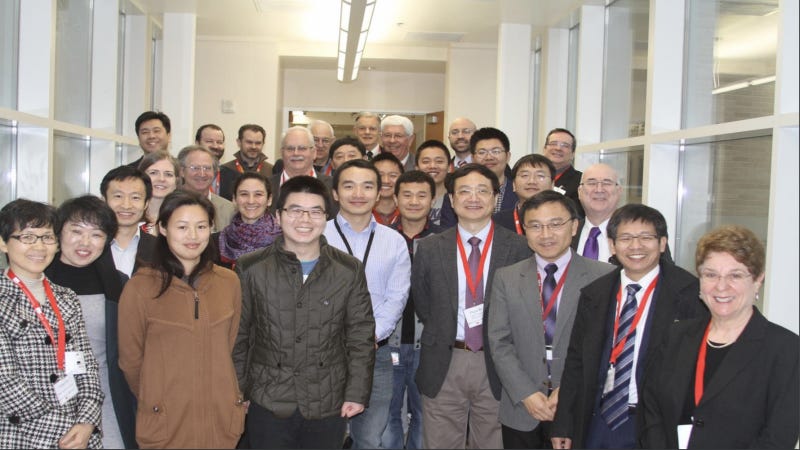
Shi traveled to UTMB Galveston in January 2018 for a NAS meeting on emerging diseases and BSL4 safety training. She remained in email contact with her Western partners like UNC UM OSU CSU UTMB FDA and Fauci. And she shared reagents, Chinese bat kidney cells and bat samples with her Western partners. Shi also collaborated with Fauci’s RML scientists from 2019-22.
Why Western virologists loved Shi’s live bat colony?
Shi now runs a lab of about three dozen researchers at the WIV. Oddly for a state employee of her status, she is not a member of the CCP. Shi is just listed as a “non partisan person” according to official media. Her official title is director of Emerging Infectious Disease (EID) at WIV, but her email signature (page 262) simply states “Senior Scientist & Professor.”
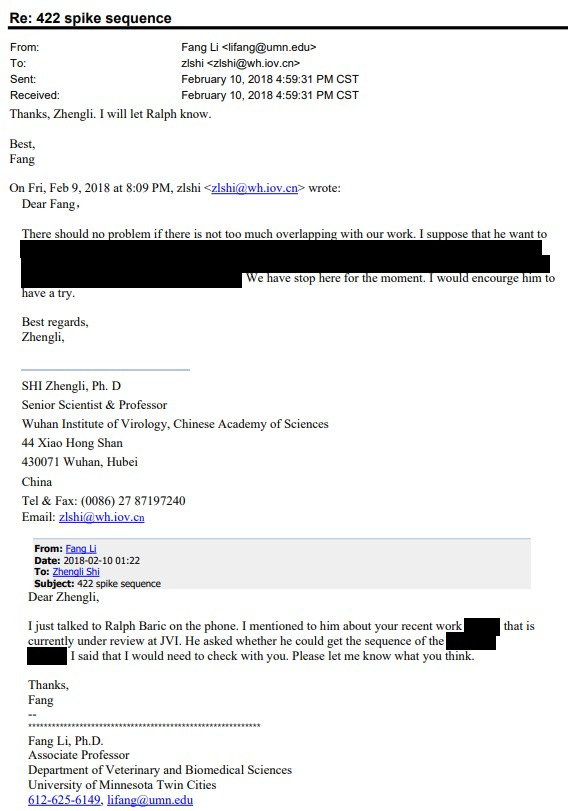
You can tell someone’s scientific interest by looking at their patents. Her American collaborator Ralph Baric held patents for reverse genetics and vaccines. But Shi and her WIV colleagues were breeding and feeding bats. WIV filed two recent patents on breeding and feeding bat cages. She perfected her methods over the past decade of “raising bats.”
The “artificial breeding method for wild bats” patent was a detailed six-step process. Meal preparation for the bats includes one week of detailed temperatures, proportions, and time for preparation of…worms. Step two is a paragraph of instructions for hand-feeding bats via tweezers, what Linfa called the “puppet show.”

Shi wanted her bats kept in a quiet surrounding of 55db; the sound of a coffee pot percolating. During hibernation, starting late October, lower lab temperature 1°C every week for eight weeks until reaching 12°C (54°F). And reverse the process coming out of hibernation in mid March.
A potential October lab leak would coincide with the hibernation schedule of a live bat colony.
Shi and her WIV colleagues even specify the amount of fresh air needed; not much, similar to stagnant bat cave air. The bat breeding was similar to domesticated animals: feeding on pure milk for two years and, by age three, one litter of pups produced per year. The 12-hour on/off light cycles are specified at 10 to 20 lux, which is outdoor twilight.
Is this the reason why UV light kills Covid?
Shi and the WIV colleagues achieved 85% survival rates using this patented method. Insect-eating Chinese horseshoe bats are so fragile and high maintenance they can only be kept alive in Chinese biolabs. Western labs prefer lower-maintenance fruit bats. Shi’s breeding and “hand-raising” bats for bio-lab experiments was not unusual. US scientists were also raising bats (4:22:00), African rats, and deer!

Why Wuhan?
Wuhan is similar in size and population to Chicago but has a GDP closer to Atlanta. Its modern metro system opened in 2004 and is nearly as big as the NYC subway. Remember the Wuhan bat soup stories? It started with social media videos originating in Indonesia but was officially pushed by an NIH contractor in a February 2020 press conference. Bats are not found on Wuhan menus, but they are found in the local biolabs.
The WIV in Wuhan was the first lab to connect SARS1 in 2003 to Chinese horseshoe bats, and therefore, it became an international center of academic research (PLA monkey labs are near North Korea). The ‘smoking gun’ for a Wuhan-area lab leak was human-to-human transmission in a city frequently visited by Western virologists, a city that specialized in studying live Chinese bats carrying coronaviruses.

Virologists not taking responsibility for a Wuhan lab leak was the equivalent of BP claiming its Macondo well did not cause the Gulf of Mexico oil leak or Exxon claiming the Valdez was not responsible for the Alaskan oil leak. Comedian Jon Stewart best summarized the geographic coincidence of Wuhan.
Why did a bat virus jump species at the exact same time and location as a similarly proposed DARPA experiment? But try not to conflate lab leaks (accidents are very common) with lab origin (US biolabs ship samples internationally). If SARS2 was engineered, wherever it spills over into the human population (e.g. Wuhan) does not tell us where it was engineered (e.g. USA).
The ‘Spanish flu’ of 1918 probably originated in Kansas but was censored by US newspapers. The debate on the origin of SARS2 was also censored by Western media. The origin of AIDS was contentiously debated but may have evolved from a contaminated vaccine developed by a US lab. The Congo in 1960, like Wuhan in 2019, was not a random spot on the map. Two scientists on the Fauci SARS2 teleconference were also involved in the AIDS origin debate. The same African “Bushmeat lobby” evolved into the Wuhan “wet market” lobby.
A division of labor that started very well
In 2013, a coronavirus 99% similar to a Chinese strain spread to America via imported pig feed, and wiped out 10% of US pork production. It was later traced back to Chinese bats. That same year Dr Ralph Baric from UNC traveled to Wuhan to discuss “research strategies and collaborations.” He met with Shi and Daszak, who were already collaborating with Linfa. Shi and Daszak on the field team collected bat samples from China and shipped them to North Carolina. And Fauci’s NIAID started funding this tight team of four for the next six years.
In 2013, Shi emailed an unpublished Chinese bat sample called SHC014 to Baric. Shi could not isolate the sample, so Baric used his patented reverse genetic method to create an infectious clone (lab created version) in North Carolina. The paper was controversially published two years later in 2015.
Baric did not isolate the Chinese bat virus; he created the Chinese virus based simply on its genome sequence, sent by Shi via email. He ‘resurrected the virus’ based on an emailed sequence. To repeat, Baric’s lab in North Carolina was able to create a live Chinese virus based on an emailed genome sequence. No other lab on the planet can do this with a 30,000bp genome. We know because he brags about being able to do it, in front of his own international peers! (5:34:00)
“It is a complicated supply chain, but the genetic sequences of the bat viruses that we discovered in China are put online (Genbank, GISAID) and have been used to help test drugs (like) Remdesivir. This is all done without even the need for a culture of the virus, or shipping viruses internationally,” per Daszak via email to WP regarding Chinese pathogens in US labs.
Shi uploaded bits and pieces of RaTG13 in 2016 and 2018 to NIAID’s database, which did not release until 2022.
Shi was listed as a co-author on the 2015 hot potato paper for sharing an unpublished SHC014 Chinese bat sample, which the WIV could not synthesize (engineer). UNC was the only US Government select agent coronavirus lab where “some virus growth studies will be conducted in primary human airway” cells. That 2015 paper was on Fauci’s mind at midnight, just two hours after being told SARS2 “looks engineered” on January 31, 2020.

In a 2015 interview, Baric described the controversial paper (9 min) and furin cleavage sites (15 min) being the biological key for jumping species.
He said, She said
To appreciate the engineering capabilities of modern virology, Nicholson Baker in NY Magazine, laid out a plausible lab leak hypothesis (that convinced me). But to provide the evidence for potential genetic engineering, Baker had to reference the Corona King, Ralph Baric 40 times, which was three times more than Shi. For Yuri Deigin’s Medium piece, he referenced Baric nearly as many times as Shi.
The 30-year NYT science writer Nicholas Wade claimed Baric “taught” Shi how to engineer SARS2 and called it “their work,” linking to a paper that Shi had zero to do with regarding engineering. Co-authorship is a complicated scientific subject, but the corresponding author (last name listed = lab) is more important due to ‘tacit’ knowledge, which is “we can know more than we can tell.”
Wade claimed that “if the SARS2 virus were to have been cooked up in Shi’s lab, then its direct prototype would have been” the 2015 paper. She couldn’t reverse engineer that paper, and it was actually a prototype for UNC to follow in creating SARS2.
UNC and Fauci in 2015 would purposefully not upload the complete synthesized lab made genome (SHC014 now oddly called SHC015) to keep their reverse genetic method “obscure” or confidential from bioterrorists and the Chinese. UNC deleted 2,000 words from their controversial 2015 paper. In 2012, UNC was given de facto monopoly on SARS research, because of its expensive select agent status, which required FBI security clearance.
Ironically, Baric and NIAID would upload the MA15 sequence five years later, in May 2020 (“it is a Catch-22”), to try and quiet the SARS2 engineering rumors. Both Penn Med and OSU virologists, on the October 2019 SADS teleconference with WIV, would help Baric and Shi organize a formal letter. It claimed, “No credible evidence supporting claims of the laboratory engineering of SARS-CoV-2.”

Per LeDuc at UTMB, Shi did not have the necessary biological tool (infectious clone) to create SARS2. Shi was still plucking prawns from the Yangtze River, when collaborator Baric of UNC created and patented the first infectious clone (lab-created version) of SARS in 2003. UNC’s No See'm biotechnology was not used to confuse the lab origin debate but to confuse an animal’s immune system into thinking this virus is natural and (ironically) local; therefore, it is more likely to inoculate the local bat species.
What can Shi engineer?
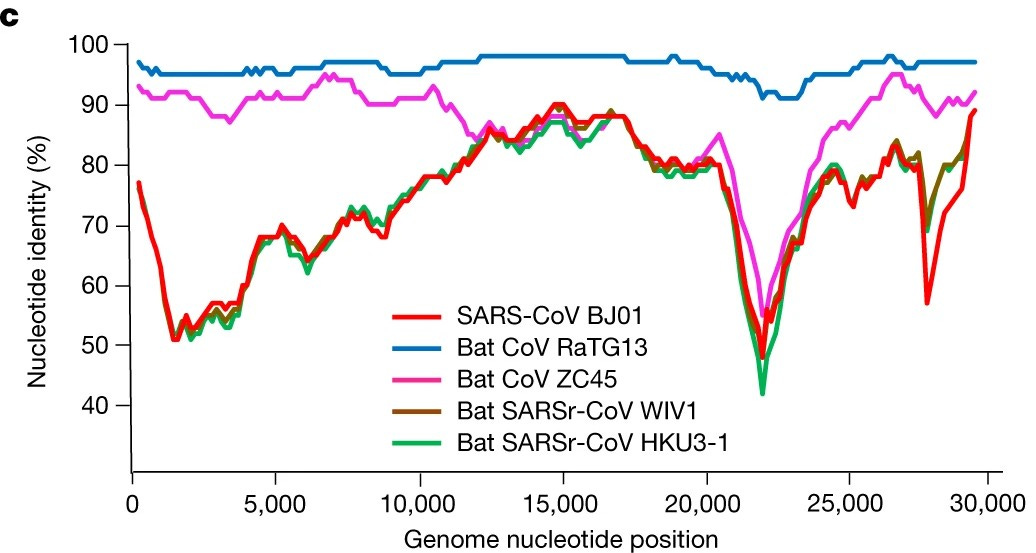
Shi was a world class isolator of bat virus from bat guano. She can take a live virus out of bat crap and culture it in a lab. Therefore Shi can engineer anything that has to do with that WIV1 sample, collected and isolated in 2013 with Linfa. Per a UNC collaborator, it was an “amazing thing that (Shi was) able to isolate that virus (WIV1) at all.” Up until 2021, Shi’s lab was the only lab on the planet that could isolate bat viruses. In 15 years, the WIV has only isolated three viruses, all very similar to SARS1 and all very distant from SARS2.

Shi can also shuffle spikes (~10% of genome) into this WIV1 backbone. In a 2017 NIAID funded paper, Shi showed the world what she was able to do, shuffle spikes into an existing backbone. But as of 2017, Shi had a 25% ‘success rate’ doing just that, shuffling spikes into an existing isolated backbone. It is called recovery of an infectious clone and it is not easily done. Compared to modern Western coronavirus labs using cDNA, it is Chinese junk using BAC.

To paraphrase Christian Drosten (Fauci of Germany) Shi could make a new car stereo (WIV1 strain) but not a brand new car (SARS2 strain). Drosten also pushed natural origins but commented on DARPA Defuse. “It also became known that there were plans to incorporate furin cleavage sites, but this was to be done in an American laboratory (UNC) and the project was not funded (by DARPA)."
Baric would ironically confirm that Shi could not create a new backbone (i.e. SARS2). Shi could only shuffle spikes into an existing backbone (i.e. WIV1). Per Baric, Shi’s lab “developed their own molecular clone, based on WIV1, which is a bat coronavirus. And into that backbone, they shuffled in the spike genes of other bat coronaviruses.” Baric would also confirm he did not send “any of our molecular clones or any chimeric viruses to China.” But there was an intermediary lab, located in Montana, involved in this fiasco.
SARS2 does not infect anything in Shi’s lab?
Early in the outbreak, labs scrambled to find the right animals for coronavirus studies. They were trying to develop an animal model for testing SARS2 treatments and vaccines. But there was one problem? SARS2 does not infect regular lab mice. The virgin virus from Wuhan (wild type) does not infect regular lab mice or rats.
Lab mice are an ‘infection’ model for viruses, but mice are not airborne ‘transmission’ models for SARS2, unlike some USA (lab) animals. One 2020 paper, referenced nearly 70 times, claimed aerosol transmission between hACE2 mice but noted “no viral RNA was detected in any of the samples.” That means no onward transmission, like Covid in humans.
Most lab animals only show a one-off infection (i.e., antibodies) in a laboratory setting. Very few show onward transmission. Oddly, later variants of SARS2 could infect regular lab mice, as this SARS2 ‘animal vaccine’ reverts to its original laboratory state.
The transgenic mice provided to Wuhan by UNC can show infection but, again, no transmission. The infamous ‘humanized’ mice with human lungs never left UNC. In 2015, Baric stated no published transmission model for coronaviruses. In 2020, when Baric was asked about transmission models for SARS2, he was a bit cagey with his answers.
The dead Danish ferrets were actually American mink called Neovison vison. They were found with bloody noses in Michigan (same species), but American mink are not found in China. They are found in Fauci’s Montana lab.
Fauci testifies to Congress
The NIAID public record 2014-19 R01 work, with Shi and Daszak, was debated in Congress and involved ‘humanized’ mice. The (nonaerosol) R01 work occurred in Shi’s BSL2 lab located on the downtown (Wuchang) campus, not Dani’s BSL4 animal lab for aerosol projects, located on the south (Jiangxia) campus.
Fauci’s NIAID finally admitted this R01 work did involve gain of function. “From the weight loss (in mice), it’s gain of function. Tony Fauci is wrong saying it’s not.” But Fauci would truthfully testify that R01 outsourced work to Shi’s lab was ‘molecularly impossible’ to create SARS2.
A line Fauci often repeats because it was true: mice are not an airborne transmission model for coronavirus. SARS2 does not even grow in mice without UNC’s patented genetic modifications. Lab mice are safe (i.e. not airborne) because they “do not sneeze or cough” (@1h27m). Per Fauci, “anyone that knows anything about virology” knows (hACE2) that mice are not a “pathogenic or transmissible” model for SARS2.
A lab mouse did not sneeze or bite a WIV technician and spread around the world in weeks. How do we know? Because it happened before at UNC without a global incident. An airborne virus that spreads up to 60 feet through the air did not leak from a BSL2 (aka the dentist's office). But don’t worry, US scientists like Baric also want to work in BSL2 conditions, as it speeds up lab work.

Where the humanized mice rumor started, but no infection or transmission in any regular lab animals.
American mink, bats, and deer do sneeze, so they can transmit disease through the air.
If there was a nefarious element to all this public record work in Wuhan, per Fauci it serves “as understanding what was going on in (their) laboratories.” NIAID would send a letter admitting Gain of Function in Wuhan, but again per Baric this mouse work was safe, it does not cause global pandemics, and does not cause viruses to float 60ft through the air. The 2018 EcoHealth progress report, showing a viral load 10,000 times higher in WIV lab mice, may have been used as justification by NIAID to move to the next stage, DARPA Defuse:
involves bat vaccines, not human vaccines.
involves Shi’s Chinese horseshoe bat colony, not Baric’s transgenic mice.
involves Dani’s Asian bat immunology more than Shi’s bat sample collection.
requires Dani’s BSL4 for in vivo (live bat) testing an “aerosol” that could float through the air up to 60 feet, not Shi’s in vitro (cell culture) Gain of Function test.
involves Baric inserting “human specific” “furin cleavage sites” into bat coronaviruses, for testing at the WIV with Linfa and Dani of Duke.
Furin cleavage insertion requires UNC human airway cells.
Shi had zero interest in furin cleavage sites and vaccines.
A German, American and anonymous WHO virologist claim the DARPA Defuse grant work was molecularly possible to have created SARS2.

Is Shi still a team player? The decision
On New Year’s Eve of 2019, Peter Daszak of EcoHealth sent an email to Baric, Dani, and Linfa. Nearly one week later Linfa sent an email to UTMB Galveston on January 4 stating the “Wuhan pneumonia” investigation was ongoing and highly “explosive.” After the publication of the SARS2 sequence on January 10th, Linfa flew back to Wuhan on January 14-18th “by accident” and “pure chance.” This was his second trip to Wuhan in two months.
The second trip was probably to check on Shi and her decision to publish RaTG13. He claimed the timing was “pure chance,” but he probably managed two NIAID funded projects in Wuhan: one for Dani and another with Shi, which requires “3-4 trips” per year. Linfa was the chairman of a scientific advisory board at the WIV since 2007, and he would have vouched for Dani in the new Wuhan BSL4.
Linfa claimed they discussed RaTG13. Shi wanted a closer match than 96% to prove SARS2 was a bat virus, so she had nothing to hide. Linfa joked that Shi “can publish more freely than I can outside of China.” Linfa defended Shi against lab leak rumors by stating, “They didn’t have that novel coronavirus in the laboratory.” This was a half-truth because ‘that novel coronavirus’ was in Dani’s BSL4.
Up until January 23, 2020, the nearest sample previously collected to SARS2 was a distant PLA lab near Shanghai. The samples were collected from an island closer to Japan than the Mojiang mine where RaTG13 was collected.
Shi entered the international limelight on January 23, 2020, the same day Chinese authorities sealed off Wuhan to contain a new disease. In a preprint paper, her team announced that it had found a virus 96.2 percent identical to the novel coronavirus.
When Shi published the natural RaTG13, she showed the world that SARS2 was unnatural. It brought attention to the “peculiar” furin cleavage site (PRRA), making it stick out like a bright neon virologist sign. A Taiwan professor described it as “unlikely to have four amino acids added all at once.” It is “the magic sauce of this virus, whether it’s natural or genetically modified, this is why this virus is circulating in humans.” Shi’s UNC collaborator, Ralph Baric of UNC, remained quiet about the furin cleavage site. Others rang the alarm bell, only to be quieted with NIAID grant money.
SARS2 is the only sarbecovirus with a furin cleavage site (PRRAR). It’s easy to remember as roar: R-R-A-R.
“We didn't perform any experiment with any coronavirus in which we attempted to insert a furin cleavage site. It's not within my expertise, that's simple.” Shi
Shi published RaTG13 the day after the lockdown started on January 23rd and just one month before China CDC clamped down on all lab-origin papers. All of this happened the same week the PLA took over the WIV. If Shi did not publish RaTG13, the nearest match to SARS2 would be two PLA lab samples (ZXC21 & ZC45) from Eastern China, that have nothing to do with her Wuhan lab. Ironically, by publishing RaTG13 in 2020, she brought more attention to her lab.
Was the RaTG13 bat sample the bat signal from the bat lady?
When the full SARS2 genome sequence was published on January 10th, a Tulane virologist was aware of the deadly Furin Cleavage Site in SARS2. But he would not suspect engineering until after January 24th when Shi published a similar SARS-like strain called RaTG13. It was without the furin cleavage site called “PRRAR.”

“Things were made worse when (the WIV) published the (RaTG13) bat virus sequence - a bat sampled in a different province for which they have a large collection of samples,” from an Eddie Holmes email on February 8th. He was 60/40% in favor of the lab leak theory (80% on burner phone) during the February 1st teleconference, but the Australian virologist now blames the Wuhan wet market.
Holmes was the first to publish the SARS2 sequence January 10th breaking China’s code of silence. Holmes also did not suspect engineering until after Shi published RaTG13 on January 24th; replying “Fuck this is bad.”
Holmes emphasized that Shi’s BSL2 lab was not working on anything genetically close to SARS2 in 2018-19 because their unpublished paper (with RaTG13 sequences) was under a four year embargo.
The Scripps virologist who told Fauci that SARS2 “looks engineered” on January 31 would later lie. After the Fauci gate emails were released in 2021, Kristian Andersen claimed RaTG13 was published after the Fauci February 1st teleconference, but it was before, so Shi publishing RaTG13 was the SARS2 engineering tattletale. Again, when Shi published the natural RaTG13 sample on January 24th, she showed the world SARS2 was unnatural.
The SARS2 ‘engineering rumors’ and Fauci’s teleconference started days later. Both the Scripps and Tulane virologists were later added to Fauci’s ongoing $82M CREID network, which potentially funded the creation of SARS2 (more details below). The Tulane virologist recently admitted the CREID grant proposals were submitted in 2019. He now claims SARS2 was a “product of nature.” Duke was the leading CREID contractor, with both Linfa and Dani of Duke-NUS listed as Southeast Asian CREID contractors but not Shi.

Fauci summarized Shi best: “I don’t know her. In fact, I’ve never met her. But I’ve talked to virologists who interact with her, and they say she’s a scientist who’s very talented, has a high degree of integrity, and is someone whose major purpose is to prevent outbreaks from occurring. As a matter of fact, she is one of the investigators who discovered the ultimate connection of SARS-CoV-1 to the animal kingdom. I don’t think very many people recognize that. She is a member of the American Academy of Microbiology. So she is a very well-recognized scientist.”
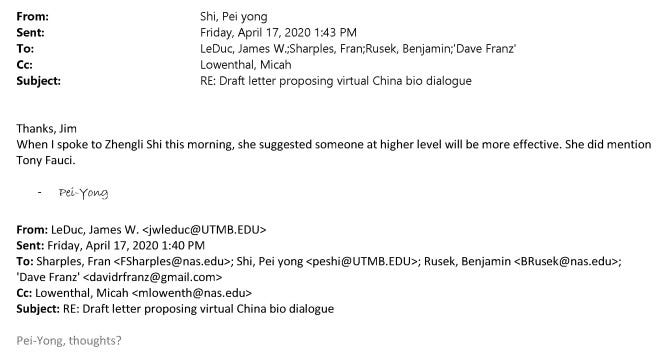
"All our research results are published in English journals in the form of papers," Shi said. "Virus sequences are saved in the [US-run] GenBank database too. It's completely transparent. We have nothing to hide.”
Shi started uploading bits and pieces of RaTG13 in 2016 and 2018 to NIAID’s database. NIAID would sit on this important Chinese genome sequence until 2022. Again it was a 96% match to SARS2 but not released by NIAID’s database for four years.

“I would personally welcome any form of visit, based on an open, transparent, trusting, reliable and reasonable dialogue. But the specific plan is not decided by me.” In the summer of 2021, Shi told the NYT “my” lab was not involved in gain of function, and “I” did nothing wrong, so “I” have nothing to fear.
We are the autobots, not the decepticons
So what caused the US Government to hop in bed with the Chinese government and cover up the lab leak? Fauci and the NIH had collaborated with China for “decades” but break the question into two pieces for clarity.
Why would Beijing cover this up? Its local officials cover up everything. It was perfectly acceptable to lie if saving “face” (aka 面子 or miànzi).
Why did Western virologists lie? The individual Western version of ‘face’ is Ego. In a small niche group, everyone acting in his or her best interest will be in the group's best interest.
So yes, China covered up the lab leak, but Fauci, and his army of virologists, covered up what leaked.
Disclaimer: again this is a hypothetical as Shi is blameless for something potentially created by others, discussed in part #5. NIAID had already funded most of DARPA's proposal, and Baric had a close relationship with Fauci, unlike DARPA, which rejected the grant. Baric and his colleagues specifically said UNC would insert human specific furin cleavages (published in 2018) into Chinese bat viruses for testing in Wuhan. Baric recently received $65M from Fauci’s NIAID and has gone radio silent, unlike Shi.
Whataboutism (inside American biolab baseball)
Theories of SARS2 originating from a human vaccine trial are mainstream because this virus was preadapted to human infection. In reality, it was the double-edged sword of a live attenuated vaccine (LAV), which are ideal for animal vaccines, but never approved for human vaccines.
Virologists are glorified veterinarians, zoologists and bat immunologists. They chased large (US) biodefense and private money projects that centered around animal health (less regulations and higher margins). A One Health idea from Canada to Australia. The CEO of Pfizer was a veterinarian repurposing a cat drug Paxlovid to treat Covid.
Pfizer exited the human vaccine business years ago because “we saw no profit and too high a risk,” McKinnell said. But he said he was encouraged by President George W. Bush’s plan calling for a $2.8 billion investment in new flu-vaccine technology.
China has access to a lot of lab monkeys but those are huge animal facilities in Harbin (which Baric visited in 2019), Kunming and Beijing labs. The WIV was an urban civilian lab with very little monkey research and no approval before 2020. There was one lab animal the WIV housed that virologists preferred: live Chinese horseshoe bats! And Wuhan was the live bat capital of the world.

The WIV was not the only institution caught deleting sequences; they have company with the NIH. China explained their side of the deleted SARS2 sequences versus the NIH “withdrawn” SARS2 sequences. The ‘missing’ sequences probably showed earlier cases away from the wet market. In a recurring theme, Fauci held a weekend meeting to discuss (bully?) the preprint from becoming public.
The NIH possibly delayed the publication of the new SARS2 genomic sequence. A Chinese scientist (Dr Zhang) flouted the Chinese info ban and uploaded the virus genome to a public database hosted by the NIH on January 5th. The NIH database requires a lengthy review of new genomes so days passed without the urgent information going online. Nearly one week later it was posted on a virologist message board. Dr Zhang’s lab was closed for “rectification” just two days later. “By then, two genomes from the Chinese Centers for Disease Control had been available for about 24 hours on an international database called GISAID.
Shi also had to (re)upload RaTG13 on January 24, 2020, to the password protected GISAID. She did this to get around NIAID’s NCBI database embargo on RaTG13, uploaded in 2018. Again, NIAID’s database would sit on this Chinese genome sequence until 2022.
International virology
The losing DARPA Defuse $14M bid was four teams spread over two continents. The winning $10M DARPA Preempt bid consist of five teams spread over four continents. The $82M NIAID CREID project consisted of 10 teams spread over five continents. They all collaborated, attended the same bat conferences, and signed MTA’s to share virus samples, reagents and antibodies.
A lot of people have a hard time understanding how often virologists share virus samples. “The mail is filled with little envelopes with plasmid dried onto filter paper that scientists routinely send each other.” A Canadian scientist lost her job for sending WIV samples without the proper MTA paperwork. DARPA was shipping coronavirus samples from China and Georgia (the country) to Atlanta, Georgia (US CDC headquarters).
The US CDC BSL4 lab in Atlanta keeps a live Egyptian Fruit bat colony (Rousettus aegyptiacus). Around 2014 both Linfa Wang and Vincent Munster (4:20:00) envied a live bat colony. There are now only two other BSL4 labs with this type of bat; Germany and Munster in Montana.
SARS2 transmits efficiently and Egyptian “fruit bats showed characteristics of a reservoir hosts. Egyptian fruit bats are not found in China or Chinese labs.
Shi shared Chinese bat kidney cells with US Universities. Baric shared his specialized mice with Shi “under an MTA, a requirement dictated by scientific journals to ensure the free exchange of reagents needed for research purposes only and fully supported by the NIH.”
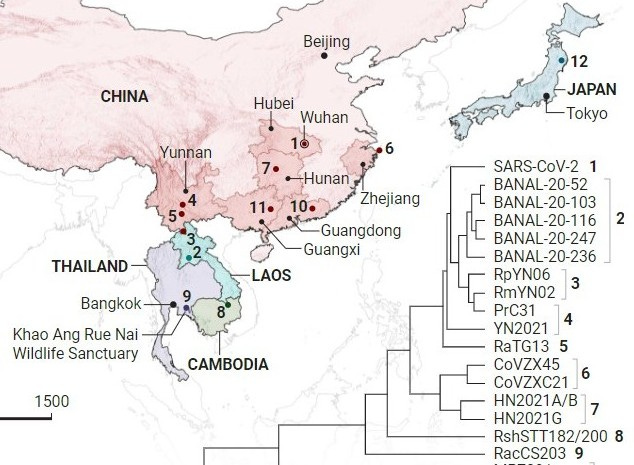
Dani Anderson shared her personal experience of interviews regarding her lab work in the Wuhan Institute of Virology from government bodies. Surprisingly, there was a lack of basic understanding of the typical work that happens in a lab, e.g. whether people work with bats in a lab, and dispose of carcasses by selling them at markets. This suggests a key role for our (Lancet Commission) Task Force in helping explain to the public how a typical BSL-3 or -4 lab functions. Likewise the public also has little knowledge that scientific work is based on collaboration and on extensive collaborative work internationally. It highlights that the public will need very basic background knowledge if the work of the Task Force is targeted for the public.
RaTG13
The 96% match to SARS2 was originally called Chinese bat sample 4991. It was collected in 2013 from the Mojiang mine about 1000 miles southwest of Wuhan. The 2013 bat sample expedition was partially funded by Fauci’s NIAID and USAID Predict. The sequence was published (KP876546) in 2019. Shi had partially uploaded the 4991 genome sequence to NIAID’s database in 2016 and renamed it RaTG13 in 2018.
Why didn’t the WIV upload RaTG13 earlier? They couldn’t even afford a $1M Illumina sequencing (the worlds most interesting company) until 2017-18. Their HiSeq 3000 unit was 2013 technology and was basically the toaster oven of Western virology.
Hypothetically had Fauci given Shi his entire $6B NIAID budget, which was twice the size of DARPA’s, and it was still biologically impossible for anyone in Wuhan to engineer SARS2. The CAS $24B budget for 60,000 employees is peanuts compared to HHS $1.7T budget (NIH, NIAID, CDC, FDA, etc) for 60,000 employees.
What about the WIV breaking the link of RaTG13 and the Mojiang mine? It was reported in January 2020 (with a typo). What about the three dead Mojiang miners of 2012? Probably on USIAD payroll but reported in 2014 and linked to rats, not bats. The Mojiang mine was such a news event a BBC reporter was blocked trying to get near it. A WSJ reporter was able to mountain bike near it (using DRASTIC GPS) but was later detained and had cell phone pics deleted.
The incident could have been used by NIAID as justification for funding a DARPA Defuse type project. NIAID funded a 2018 study of rural Chinese living near bat caves showing SARS like antibodies. In 2020, Baric pushed this theory that a bat virus could jump directly into humans without an intermediary host. Also in 2020 Linfa asked, “in Wuhan, if three people died and it was controlled, would we know it? No. This is happening all the time. It is just in remote villages where people die. You bury them and end of the story, right?”
Yes, the WIV collected a lot of viruses, because they were paid by the US Government to do just that. Claims of 22,000 samples were exaggerated since the WIV has only isolated 3 samples (WIV1, WIV15 aka 4874, and WIV16). This is three more samples than any other lab on the planet. The WIV also published sequences in early and late 2019 so apparently they had little to hide.
Yes, Shi isolated and tested these SARS like viruses (WIV1, WIV16, SCH014) because SARS1 was still of interest in China, but these are almost 25% different to SARS2. Yes, there is an uncanny HIV ‘insert’ in SARS2, but it is also found in RaTG13 and Banal Pentagon samples collected in Laos.
Yes, everything about RaTG13 was weird and a close match to SARS2, but why even publish RaTG13 if you have something to hide? Because they had to? WIV published RaTG13 one full week before Wuhan University published 4991, which itself did not know about RaTG13, so they also had nothing to hide.
It was not easy to see that SARS2 was engineered. It was synthetically designed to look natural to the Chinese bat immune system. Even longtime biosecurity expert Richard Ebright told US media on January 29th that “based on the virus genome and properties there is no indication whatsoever that it was an engineered virus.” This line was repeated on February 5th to Chinese media (same infamous article about Shi swearing on her life).
A list of (non) answers from various lab leak proponents as to why Shi published RaTG13. Two of them even wrote a 400 page book about RaTG13 but neither can answer. And no, RaTG13 was not fake. It was partially grown in hamster cells in Hamilton, Montana.


Shi made clear RaTG13 was just that, a sequence that “I would like to emphasize that we have only had the genome sequence and did not isolate this virus” and Shi’s lab has shown zero ability to recover infectious clones from a sequence alone (UNC has proven track record).

How a bat virus traveled 1000 miles (NIAID) and 1500 miles (DoD in 2017) from Asian caves to WIV via US labs
SARS2 can only be grown in vitro using human airway cells, exclusive to Western biolabs with a lung or cystic fibrosis department, like UNC.
Furin cleavage site
Yes, Shi missed the peculiar and deadly furin cleavage site, but the WIV used 20-year-old MS-DOS software that truncated at the exact same spot in their 2017 and 2013 papers. There was probably a mad rush on January 23rd when the Wuhan lockdowns were announced, so let us be thankful the sample was published. It is a clue, one way or the other.
Most Western virologist knew about the odd furin cleavage site by January 12th when the SARS2 sequence was published, but none suspected engineering until after Shi published RaTG13 on January 24th.
WIV used Vero E6 (primate) cells which kick out a furin cleavage site “immediately.” Any furin cleavage site was deleted in Vero cells. Vero hSLAM and CaLu-3 lung cancer cells can be used as an alternative for a stable furin cleavage site, but SARS2 first infects the human airway (ACE2) not the lung. The WIV would need access to primary human airway cells.
Ebright later lied to Congress about primary Human Airway Epithelial cells inside the WIV. Air liquid interface HAE is exclusive to UNC and required for furin cleavage site insertion, since Shi’s Vero cells would delete. UNC discussed the “harvest” procedure (50:00) of the cells from lung donors.
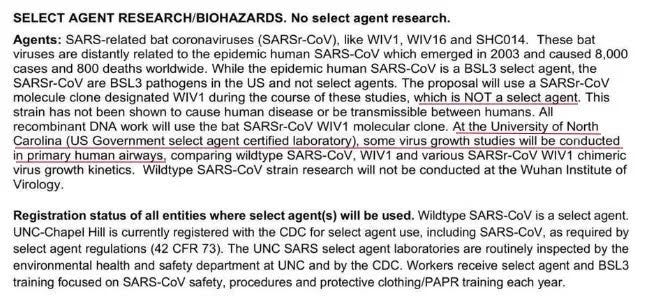
More prominent US virologists, with access to human airway cells, would also ‘miss’ the same furin cleavage site in the same week. And Shi would never be caught lying to the US Military or US Congressional staff about this deadly furin cleavage site.
Shi published the furin cleavage site in a January 20th paper, just misaligned because of something called a “death-inducer obliterator.” In a February 25th paper, the furin cleavage site was properly aligned. Shi discussed the furin cleavage site (in English) during a December 2020 webinar and (in Chinese) during a March 2020 “PRRA” webinar.
This was more public discussion than any of her Western team members, who were developing furin cleavages for coronaviruses in late 2019 and 2018. No lab in Wuhan (or even China) has ever published interest in furin cleavage sites before 2020.
Shi and Linfa were studying bat immunology (STING) in 2018, an important piece of Defuse type work, which Dani was a specialist. WIV captured live R Sinicus bats, mentioned in DARPA Defuse, from a cave 1 hour south of Wuhan.
We do not need to study much of Shi’s work because she did not publish any papers on furin cleavage sites or even vaccines before 2020 (the only hit was that 2015 paper she has zero to do with). Furin was seen as cutting edge Western biotechnology, fascinating scientists for its ability to “measure once, cut twice.” Ironically it was openly discussed with Baric in a 2015 Gain of Function meeting.
Many virologists accepted possible lab leak after Defuse leaked in September 2021, noting it was impossible for the WIV to engineer SARS2 in Wuhan. “A possible transmission chain is now logically consistent — which it was not before I read the proposal.”
WIV vs UNC
There was simply no engineering ‘collaboration’ between Baric or Shi, as both have noted in subsequent interviews. Per Baric, Shi was listed as a co-author on his infamous 2015 paper because she “graciously” provided Chinese bat samples (SHC014) before being published. And Shi didn’t even have the biological tools to work with that virus, so she had to send it to Baric. Both sides maintain this was not a close working relationship, no exchange of lab staff.

B.L.Y. stands for Boyd Yount who is Baric’s 30 year bench scientist, listed on many patents, and infectious clone guru.
On January 24, 2020 interview Baric discussed his Wuhan collaboration (23 min) and pushed the wet market theory. They discuss (46 min) how hard it would be to ship the Wuhan virus to USA. Baric says UNC will “synthetically resurrect the virus” based on the genome and mentioned Shi’s January 24th preprint.
Yes, Fauci funded some risky GoF experiments in Wuhan but these have zero to do with SARS2 (no furin cleavage site, not the same WIV1 backbone, not airborne, doesn’t infect deer, etc). The R01 bat surveillance GoF work debated endlessly in Congress was basically Fauci “understanding what was going on in their laboratories.” Most media discuss and debate the R01 work via EcoHealth alliance. (Great summary here)
In the biggest ‘own goal’ in biological history, we know Shi cannot engineer SARS2 because of her public record GoF experiments, partially funded by NIAID. Shi did not even have an “infectious clone” which was required for engineering SARS2. UTMB even asked NAS for permission to send an infectious clone to the WIV in March 2020.


One year later, UTMB would outline the six step process of engineering SARS2 and “due to the large size of the coronavirus genome (~30,000 nucleotides long) and several toxic genomic elements, manipulation of the reverse genetic system of SARS-COV-2 is not a trivial task and requires sophisticated methods.”
UTMB, a world-class BSL4 studying coronavirus, had never developed a reverse genetic system for a SARS-type virus before 2020. UTMB later offered to share their infectious clone with Shi and WIV. Regarding stolen or shared biotechnology with China, a former UNC postdoc now at UTMB, was caught sharing IP from Baric lab: “If you can't understand my frustration, then you are correct and we have a problem.”
SARS2 is a Master of Immune Evasion, which some interpret as a bioweapons program. But like any good self spreading vaccine candidate it was designed to evade the immune response e.g. using Nsp1 and using Orf8 Orf6 etc. Any pre-existing immunity to the vaccine vector would slow the vaccine spread. Baric even patented methods to “modulate an immune response in a subject without deleterious effect on the subject.”
WIV database
Yes, the WIV database was offline in September 2019. In that same month Shi travels to Sweden, Africa and Paris. It remained offline in October and November but back online December, January, February 2020. WIV claims it was then taken offline for security reasons in February. USAID Predict partially funded the creation of that WIV database and the program also ended September 2019. US academic biolabs apparently kept a copy of the WIV database (pg 262 & 871).
We do not need to see the WIV database since Shi thankfully published RaTG13 one month before the clampdown. But we will later learn UNC had already published a “fascinating” and “unique” fragment of RaTG13 (UGGUCGC) in a 2018 “national security” LAV bat vaccine paper, referencing the “lethal human sequences” of the Mojiang mineshaft.
Baric told Italian TV that the SARS2 origins “would only be in the records of the WIV” but will be find evidence in UNC.
Baric’s UNC freezer is of great interest but has never been scrutinized. As one anonymous virologist put it: “I would be afraid to look in their freezers.” Baric himself wrote “Several CoV infectious eDNA clones are available in the lab, including SARS-CoV, MERS-CoV, conventional human and model CoVs, and several bat CoVs with pandemic potential.”

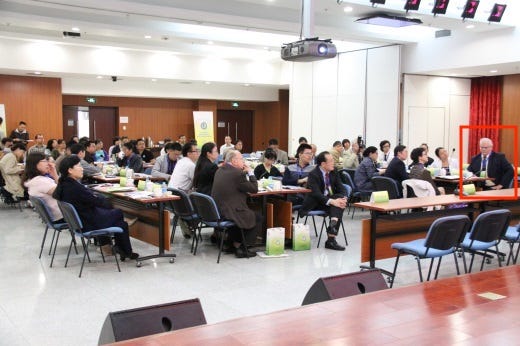
Basically every sample the WIV collected, Baric had a copy, and that was the entire purpose of USAID Predict. Baric brags that UNC has “reverse genetics for SARS-CoV, MHV, MERS-CoV, HCoV, NL63, PEDV, TGEV, bat SARS-Iike CoV (SL-CoV), BtCoV HKU-5 and others.”
Shi can clone WIV1.






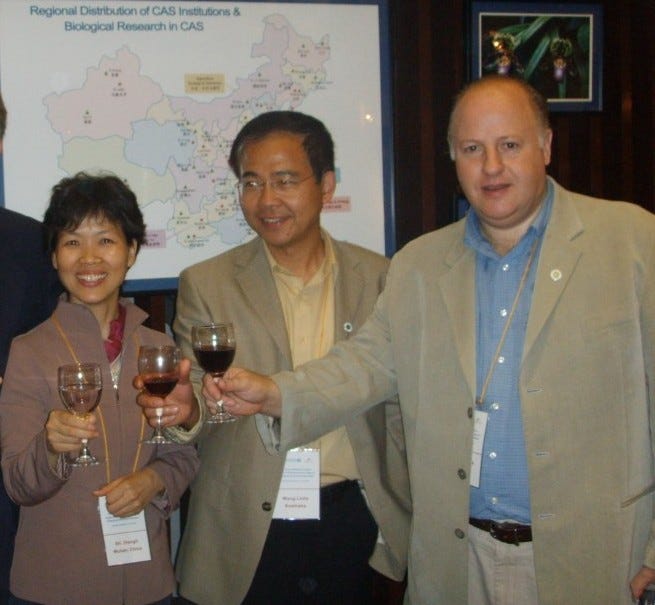


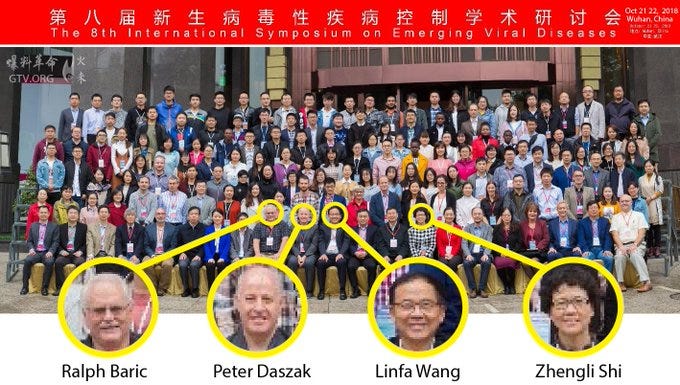

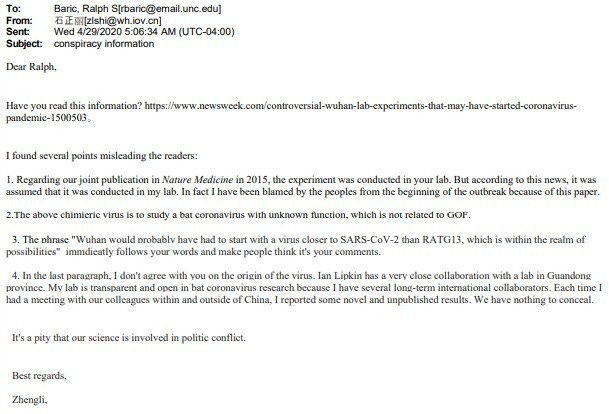
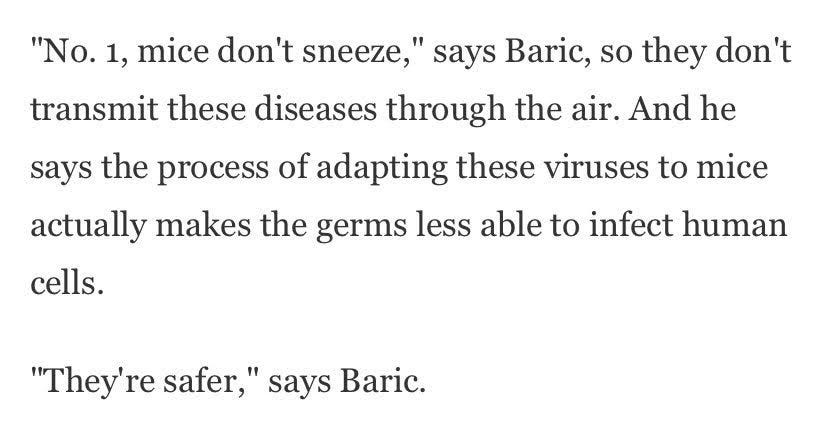
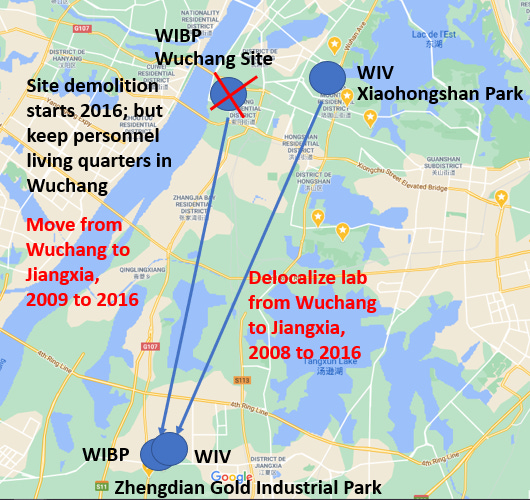


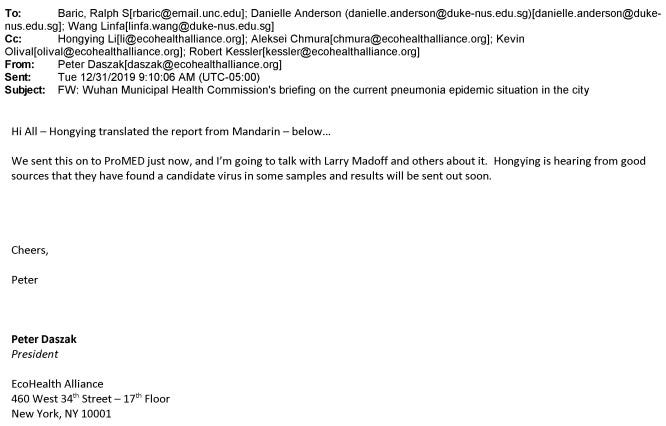
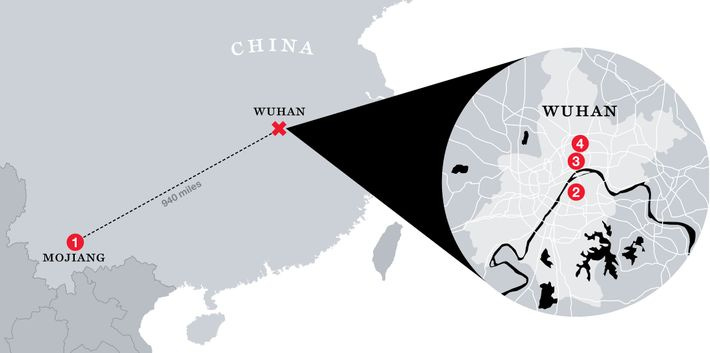

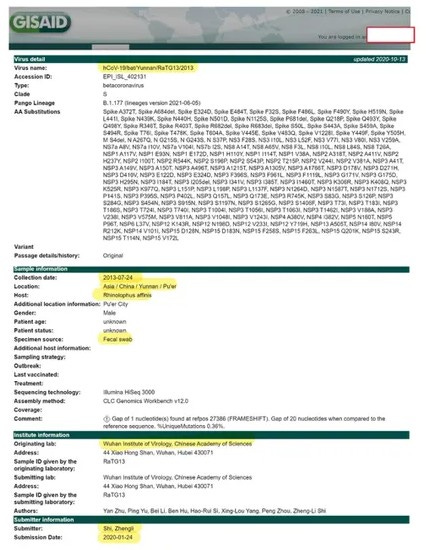

Home run.
Hi Jim, what do you make of this new preprint showing that Huazhong Agricultural University was inserting a MERS spike into a HKU4 backbone in 2019/2020? https://www.biorxiv.org/content/10.1101/2023.02.12.528210v2
The Huazhong Agricultural University also worked on the insertion of an FCS into a porcine coronavirus in 2015 together with Utrecht University: https://pubmed.ncbi.nlm.nih.gov/25972540/
Deigin mentioned that in 2013 Shibo Jiang had reported the creation of a novel RIRR cleavage site via a 12-nucleotide insertion (CGG ATC AGG CGC), although not in a coronavirus: https://journals.plos.org/plosone/article?id=10.1371/journal.pone.0080005
Are these papers relevant to the question if WIV or another Wuhan lab were able to create SC-2 in 2019?